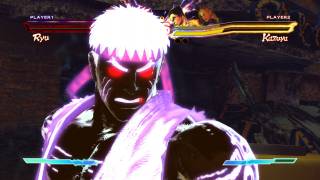Overview
A comeback mechanic allows fighting game players to make a last bid to win a round, they are typically activated once a gauge is filled or when a character is low on health.
Appearances
Ultra Combo
The Ultra Combo was first used in Street Fighter IV with one ultra combo per character and increased to two in Super Street Fighter IV, allowing players to choose which they would use for the match as with Super Arts in Street Fighter III. Ultra combos have their own meter next to the super meter, which can be filled by taking damage and by focus-attacking through the opponents attacks. Ultra combos are usually extended and more powerful versions of special moves which includes projectiles and throws.
X-Ray Attack
 Johnny Cage's X-Ray Attack
Johnny Cage's X-Ray AttackMortal Kombat's x-ray attack is a combo comeback mechanic that uses all three bars of the game's power meter as opposed to having its own meter. This in conjunction with the game's high damage regular combos mean it is seen less often than kombo breakers which cost two meters. In matches between more casual players however, the x-ray attacks are seen to be much more useful as the high damage regular combos seen in professional play are a rarity. X-ray attacks start off with a special move, going into the x-ray animation (complete with bones and organs being broken and damaged) if it successfully connects.
The X-Ray attack returned for Mortal Kombat X.
X-Factor
Featuring in Marvel vs. Capcom 3: Fate of Two Worlds and Ultimate Marvel vs. Capcom 3, the X-Factor is a mode which lights the player's team bright red and increases both their strength and speed. X-Factor has different levels depending on how many characters is alive in a time, level one X-Factor when three characters are alive, level two for two characters and level three for one character. The higher the level, the more powerful and longer the X-Factor lasts.
X-Factor is parodied in Divekick which uses Kick Factor.
Awakening
Persona 4 Arena's Awakening mode is an automatic comeback mechanic appearing when a character goes under 35% health, though it only activates when a character is in a default state, not mid-combo. This means that an opponent can potentially do a combo that does more than 35% damage and end the round without Awakening ever being used.
When it does activate, Awakening increases a player's defence by a 1/3 and extends their SP bar (meter) from 100 maximum to 150 maximum, filling that extra 50 automatically. The final benefit to Awakening are unique SP skills (super combos) that are more powerful but cost the same 50SP as normal skills.
Rage
Introduced in Tekken 6 and its home release, Tekken 6: Bloodline Rebellion, the Rage system automatically activates once a character's health falls below 10%, body parts will glow red and their strength is significantly increased. In combination with the game's other new system, "bound," the player can potentially do much more damage with a single combo than in previous games.
Pandora
 Ryu Pandora Mode
Ryu Pandora ModePandora is an all or nothing comeback mechanic in Street Fighter X Tekken. When a character has 25% or less of their health remaining they can sacrifice that character to activate Pandora in their tag-team partner. During Pandora the character has a power increase and infinite bar for super combos. The drawback however is that Pandora will only last 8 seconds and if the Pandora user doesn't win in that time, whether they have a life-lead or not, they will automatically lose the round (hence all or nothing).
Netsu Power
Originating in Tekken TAG Tournament and returning in Tekken TAG Tournament 2, the Netsu Power increases the strength (1.3 multiplication) of the player's off-screen tag partner when the on-screen tag partner takes a certain amount of hits. Netsu power features a storyline element which governs the amount of hits that must be taken before it activates. Characters that are on friendly terms or are someone they want to kill themselves will activate sooner, unfriendly characters will activate later.
Criticism
Comeback Mechanics were originally created to close the gap between lesser experienced players against more competitive players. This hasn't turned out to be the case however, Twitch.TV Community Manager Jared Rea, explains that these mechanics are more dangerous in the hands of competitive players than new players:
"We've seen this situation before with Ultra Combos (Street Fighter IV) and X-Factor (Marvel vs Capcom 3), where a new gameplay system is introduced with the intent of making the game more accessible to newer or lesser skilled players, but really all it does is reset the gap on a larger scale and the rich tend to get richer -- just imagine when you give those same tools to the likes of Justin Wong or Daigo Umehara."
Log in to comment